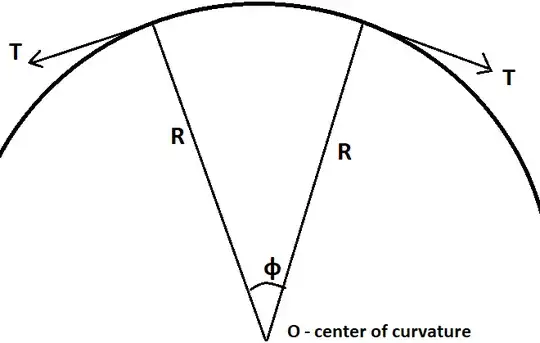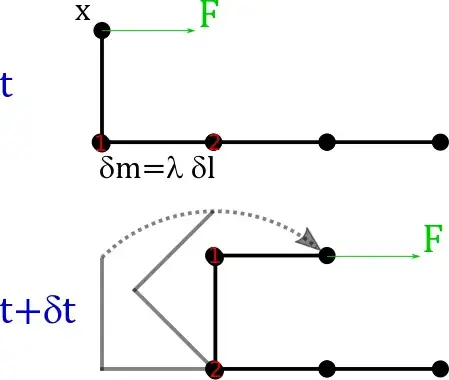Consider this system.
A long, thin, pliable carpet is laid on a floor. One end of the carpet is bent back and then pulled backwards with constant speed $v$, just above the part of the carpet which is still at rest on the floor. What is the minimum force needed to pull the moving part if the carpet has mass $m$ per unit length?
Three different approaches lead to 2 different values for the minimal force: $\frac{mv^2}{4}$ and $\frac{mv^2}{2}$. Which ones are correct? How does energy and momentum conservation happen in this specific system?
I believe correct answer to this question might be useful for general audiences and for pedagogical reasons, because it addresses a certain mistake that people often do in similar problems.
My effort at answering the question. I get the answer $\color{blue}{F_{\text{min}}=\frac{mv^2}{4}}$. Below I give detailed analysis why this is so. My solution is in agreement with conservation of energy and I explain why energy is conserved. Also an explanation from purely dynamical considerations is given by calculating the tension of the carpet at the bending region.
First attempt. Let's consider how new elements of the carpet are brought into motion.
This increase doesn't happen abruptly by a jerk, so energy is not dissipated. To see this consider a wheel moving on a flat surface without slippage with constant speed $v/2$.
 If we go in the clockwise direction from the lowest point of the wheel, then the velocity of the points on the circumference gradually increase from $0$ to $v$ at the highest point, then gradually decrease to $0$ at the second half. This is well known, no jerking motion happens.
If we go in the clockwise direction from the lowest point of the wheel, then the velocity of the points on the circumference gradually increase from $0$ to $v$ at the highest point, then gradually decrease to $0$ at the second half. This is well known, no jerking motion happens.
Similarly to the fact that energy is conserved for a wheel rolling without slippage the energy is conserved in the case of the carpet too: the work done by the pulling force $F\cdot 2L$ is converted into kinetic energy of the carpet $mLv^2/2$: $F\cdot 2L=mLv^2/2$, thus $F_{\text{min}}=mv^2/4$.
Second attempt. One might object that the bending of the carpet is not circular. In fact in the above reasoning this doesn't matter. But let's show this doesn't matter in another context too by calculating the tension of the carpet at the bending region.
We assume the bending curve has the same constant form at all times. When viewed in the reference frame moving with speed $v/2$ in the direction of the the external force $F$ this bending curve seems stationary. In this reference frame carpet 'flows' along this curve with constant speed $v/2$.

Now consider a certain element of this curve. Let $R$ be the curvature radius, $\phi\ll 1$ - the angle that this element is seen from the center of curvature. The length of the element and its mass is $mR\phi$. The tension if the carpet $T$ gives this element the centrifugal acceleration $\frac{v^2}{4R}$:
$$ T\cdot \phi=mR\phi\cdot \frac{v^2}{4R} $$
Thus $T=\frac{mv^2}{4}$ independent of the curvature.
Now we get the required minimal force that is needed to pull the end of the carpet with constant speed $v$: $F_{\text{min}}=T=mv^2/4$.
Is this analysis in agreement with conservation of momentum? There are two forces that act on the carpet as a whole in the horisontal direction: the pulling force $F$ and the friction force of the floor $F_{fr}$. If the carpet is not sliding along the floor then $F_{fr}=T=mv^2/4$. $F_{fr}$ acts in the same direction as the pulling force $F$. These two forces combined give the carpet the momentum $mLv$: $$(F+F_{fr})\cdot \frac{2L}{v}=(mv^2/4+mv^2/4)\cdot 2L/v=mLv$$ as required.
Third attempt. This is taken from the book https://www.amazon.com/200-Puzzling-Physics-Problems-Solutions-ebook/dp/B00E3UR79U . They get different answer from the two approaches above: $\color{red}{F_{\text{min}}=\frac{mv^2}{2}}$. Also they make a conclusion from this that half of the work done by pulling force is dissipated as heat.
(Solution in the book. They assume $m=1$, $L=1$.)
"It seems tempting to try to find the minimum force required by using the conservation of energy, i.e. $F \cdot 2L = mv^2 /2$, where $L$ is the length of the carpet, ($L = 1$). The result would be $F =1/4$ , which is only one-half of the value calculated earlier. The error in this argument is to ignore the continuous inelastic collisions which occur when the moving part of the carpet is jerking the next piece into motion. Half of the work goes into the kinetic energy of the carpet, but the other half is dissipated as heat." (Quote from the book)


